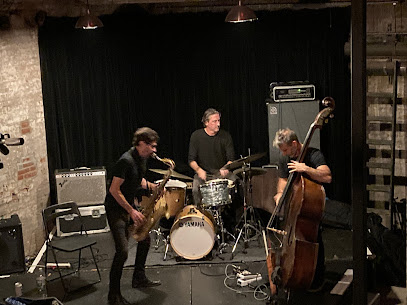 |
| Bambú |
Seemingly out of nowhere, over the past year Gían Pérez has become a suddenly ubiquitous presence on the NYC free improv scene. His meteoric rise inspired the title of his debut solo album, as comparable to a fast-growing plant like bamboo. Whatever plant it is, though, is surely not an invasive weed but rather a welcome rarity. Pérez’ unique voice on the guitar is a fresh new vision for an instrument we thought we knew.
Some of the allure of Bambú comes from its mystery. Pérez uses prepared-guitar extended techniques to conjure otherworldly soundscapes; without a visual element it’s rarely obvious how he produces these textures. His playing can be abrasive, as may perhaps be expected from a solo electric guitar improv album; just as often, however, he keeps up a concentrated stillness with moments of unexpected tranquility. Loud or soft, in this solo setting his improvising is right there, and he holds the listener’s focus with a heartfelt playfulness through all his arcane limitations. Like so much of my favorite new work, this is island music: not only from Pérez’ upbringing in Puerto Rico (referenced in a few of the track titles) but also in the sense that each of the eight tracks is somehow an island. They are well-defined vignettes rather than stories, each one cataloguing a specific technique - sort of a surreal set of field recordings.
“There, A Gun!” proclaims the opening track, but the weapon slung here is more massage than machine. An expanding and contracting sheet of noise becomes the melody, while funky lumps of thumpy accompaniment bubble under the surface. “Clave De Fo” (“Key Of Yuck”) is one of the quieter, more linear scenes, though not without a couple of spirals out of control near the end. This one shows Pérez at play, romping through rippling and boinging licks. “El Coqui y El Grillo” is well-named, though not directly imitative: the high-pitched reedy overtones characteristic of tree frogs or crickets are certainly captured in Pérez’ sprongings and scrapings. The one-minute interlude “Tres” is another boinger, this time at a more slapstick pace.
“Perreo Intenso” translates roughly as “Twerking Hard”. On this longest track, Pérez displays an eldritch repertoire of snarls, klaxons, and rapid-fire blasts. Toward the middle he seems to be coaxing crude melodies and grooves out of industrial machinery: a work zone or a twerk zone? “La Mancha” is more recognizably guitar-istic but equally unhinged, picking up where “Tres” left off with plenty of that rubber-bandy shred that can be onomatopoeia’d by rapidly repeating the word “cluster”. The title track which follows is again completely different: acoustic, chordal, even pretty at times - though without a trace of sarcasm. Even here, the raw edge that runs through this album is never dulled; the squall of percussive chords toward the end is just as feral as the other tracks’ shred and noise. Speaking of noise, “Bañar En La Coca” (named for a Puerto Rican waterfall) is a fitting title for a fitting closer: a nonstop noise torrent, just uniform enough to be more relaxing than terrifying, and perhaps the ultimate aural palate cleanser.
This music is complemented well by David Mirarchi’s cover art, a rugged collage of esoteric shapes which are clearly fragments of tangible objects but no longer recognizable. Both the music and the art are the kind of abstraction that really works: a plainly stated and sincere strangeness, never fully explained but open to infinite interpretation. Another listener could come up with a completely different description of this music from mine, positive or negative. Pérez’ commitment to this abstraction is an important part of the originality of his music. Whether you “woo” Bambú or boo Bambú, Bambú stays true to something new and will never be anything other than Bambú.





















